


CENTURION SEA ISLAND SHOW BOOTH 103, 202














CENTURION SEA ISLAND SHOW BOOTH 103, 202










What do Great Jewelry Store Design Ideas and Techniques from The Centurion Columnist Leslie McGwire and CENTURION's new Summer Show at Georgia's Private, 5-Star The Cloister at the Sea Island Resort have in common? In short, a focus on wonderful and productive environments for customers to enjoy.
In our 2024 ANNUAL JEWELRY STORE DESIGN GUIDE, we present 10 Articles by jewelry store design pro Leslie McGwire that are sure to help you along the way to your ideal store design approach.
You will learn about Creating Engaging & Immersive Retail Environments; why The Future of Retail Design is Side-by Side Selling; The Best White Paint for Your Jewelry Store Wall; Tips for Successfully Mixing Metals in Your Showroom; Jewelry Interior Design Fundamentals Every Store Needs; When to Remodel Your Store; Hingham Jewelers 75th Anniversary Store Remodel; Why is Interior Design Important for Improved Sales?; and Things to Consider When Conceptualizing Jewelry Store Layout Designs
Then jump into the world of CENTURION SEA ISLAND 2024, our new summer show taking place August 18-20 at The Cloister at The Sea Island Resort with a complete section on pages 64-70 detailing our 70+ Exhibitors, Morning Speakers, Full Schedule and Floor Plan. Exhibit space is sold out and space for retailers is extremely limited at this writing, so if you are an interested retailer, submit a registration inquiry today at https://centurionjewelry.com/seaisland/
The Centurion 2019 Park Avenue, Merrick, NY 11566 516-377-5909 news.centurionjewelry.com
Meet Leslie McGwire, Leslie McGwire & Associates Interior Design Company, West Bloomfield, MI
Leslie McGwire™ has over 35 years in business development, interior design, equipment, furniture sales and marketing services in retail and jewelry-based businesses. Leslie has won 25 national design awards, including the prestigious Salon Today and INSTORE Jewelry Store awards. Leslie has a true passion for business, design for the jewelry and retail industries. Visit lesliemcgwire.com for more information.


















“We’ve worked with GemsOne for nearly 10 years now using their mailers and extensive product offerings to engage first time customers with great success. Over the last 2 years they have taken their game and product offerings to a whole new level with the introduction of a new bridal and fashion line that has caught the attention of both our sales associates and customers”
Brian Stamey, Vice President
of
Marketing
and Operations at International Diamond Center, FL



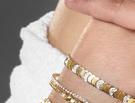



The current industry dialogue is dominated by the polarizing debate between natural and lab-grown diamonds. However, jewelers challenge extends far beyond this. It resides in the realm of marketing messaging and the formidable hurdles of di erentiation, consigning stores to a commoditized sphere where price alone dictates. There exists an urgent need to explore innovative and proven, yet underutilized, strategies to break this mold.


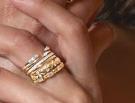





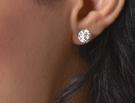
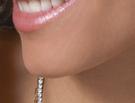

According to an article by Archrival x Vogue Business, over 70% of Gen Z and Millennials prefer in-store purchases but heavily rely on social media for research (https://www. voguebusiness.com/story/consumers/gen-z-broke-the-marketingfunnel). Retailers challenge is to facilitate this research amidst the overwhelming and costly digital marketing noise. The solution lies in diversifying digital marketing e orts with traditional techniques like direct mail, which guarantees an initial impression at a fraction of the cost. Direct mail not only supports further online research but also e ectively initiates the consumer journey.






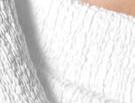



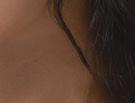
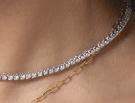




To leverage this strategy, retailers need a media-savvy partner capable of delivering direct mail that aligns seamlessly with their store’s profile and carries relevant product assortment to facilitate client engagement. Well-executed marketing campaigns can target pre-bridal consumers early in their journey, when acquisition costs are lower, positioning retailers to cultivate lifelong clients. In contrast, marketing to actively shopping bridal clients, especially purely through digital channels, is more expensive and less e cient.
Once on a consumer’s radar, the next step is crucial. Capturing the attention of today’s clients, whose journey is non-linear and whose brand loyalty has evolved, begins with compelling storytelling - not the retailer’s story, but one that resonates deeply with the consumer. Heritage stories and promises of longevity or familial treatment no longer captivate modern consumers.

The key to understanding your target audience is to admit that one of the most profound misconceptions in marketing is the belief that o ering more choices benefits consumers. In reality, excessive choice acts as a cognitive tax. What customers truly desire is not an abundance of options but confidence in the choices they are making.


The average American adult makes over 30,000 decisions a day. Each decision incrementally depletes our mental resources, leading to a phenomenon known as decision fatigue. As the day progresses, our capacity to make decisions wanes, leaving us overwhelmed and disengaged.
What insights can we extract from this?
E ective marketing hinges on consistent messaging that clearly articulates your business’s core competencies and emotionally connects with your audience. This strategy is crucial for several reasons: It creates a strong brand identity, showcases expertise to build trust, and fosters emotional connections for enhanced client engagement.
Ultimately, this streamlined approach nurtures customer loyalty, enhances brand perception, and drives successful marketing outcomes. By reducing the cognitive load on your customers, you not only improve their experience but also position your brand as a reliable and trustworthy choice in the marketplace.


Gem’s One o ers a strategic breakthrough.
Private labeling is often touted as a solution for market di erentiation, but its successful implementation has been rare. It demands a comprehensive, consumer-centric marketing strategy, ready-touse digital and in-store marketing assets, displays, a full product range in key jewelry categories, and a digital platform to enhance the in-store experience for custom design and instant bridal modifications.















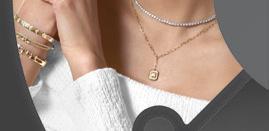



Gem’s One has devised an all-encompassing solution to position retailers for future success. It alleviates the burden and cost of marketing asset development, enabling swift deployment with a sensible investment. By building a robust marketing identity we ensure demand is generated before expanding into a wider product assortment. Our two years of market analysis and trend anticipation have culminated in an e ective approach for transitioning to a natural diamond narrative and positioning your store brand at the forefront of your marketing e orts.




For many retailers, the unrealized value lies within their own brand and now there is a strategy to unlock it.


“The three important needs for a jewelry store are TRAFFIC, TRAFFIC, TRAFFIC. The right trend items, priced properly, with the right marketing vehicles at the right time. This is the formula for traffic that Gems One has provided us for close to 20 years. Their customer retention and new customer acquistion solutions are second to none.”
Josh Halpern,
Alberts
Diamond Jewelers, Schereville, IN











JOIN OUR SHORT INTERACTIVE E-LEARNING COURSE FOR AN OVERVIEW OF THE DIAMOND PIPELINE.











CENTURION SEA ISLAND 2024 PREVIEW SECTION FOR AUGUST 18-20 SHOW AT THE CLOISTER, SEA ISLAND, GA. EXHIBITORS, FLOOR PLAN, SPEAKERS AND SCHEDULE. PAGES 64-70

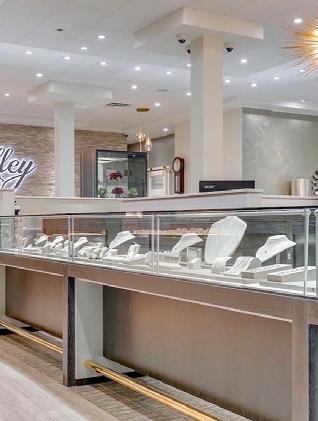

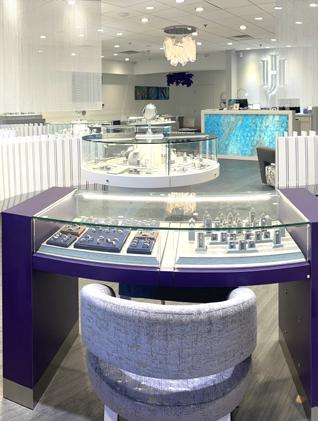
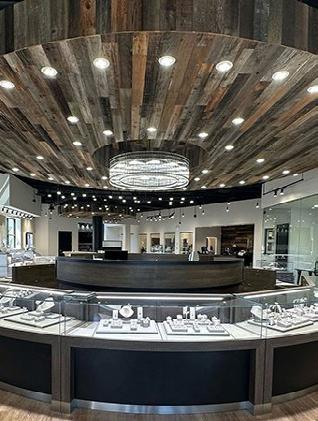
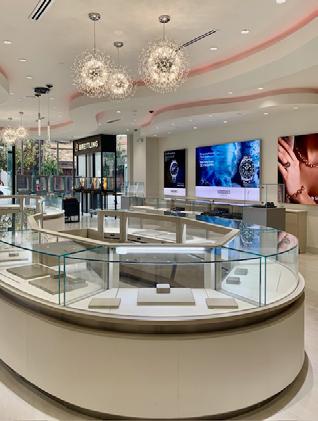




CENTURION SEA ISLAND SHOW
BOOTH 302
As jewelers strive to meet the ever-changing expectations of their consumers, interior design has emerged as a vital tool in creating engaging and immersive retail environments. In a highly competitive industry especially with the rise of online shopping, brick-and-mortar stores must provide customers with something unique and engaging that they cannot get through a screen.
Interior design plays a crucial role in shaping a customer’s experience with a brand and its physical space, extending
far beyond mere aesthetics. Its impact can be seen in everything from a customer’s mood and behavior to their perception of the brand, ultimately influencing their purchasing decisions. By leveraging the power of interior design, businesses can harness this influence and wield it to their advantage.
Here are a few interior design trends that are shaping the jewelry industry, providing brands and retailers with a competitive edge:
Experiential design: Immersive experiences that bring brands to life.
The rise of experiential design is transforming the retail industry, offering customers an immersive and engaging shopping experience. Experiential design engages all the senses, incorporating lighting, sound, scent, and touch to create a multi-sensory experience that connects customers with the brand. From interactive displays to product demonstrations, jewelers are designing spaces that allow customers to engage with their products.
Minimalist aesthetics: Clean, uncluttered spaces with open-concept design.
Open-concept design is a popular trend in jewelry store interior design, as retailers seek to maximize their space and create a more streamlined shopping experience. Open-concept design incorporates minimalistic and flexible layouts, with clean lines and uncluttered spaces that allow customers to move freely throughout the store. This design trend is especially popular in smaller retail spaces, where efficient use of space is essential.
Continues on page 28



Insta-worthy spaces: Stunning interiors that inspire social media shares.
Social media-inspired design is a trend in jewelry store interior design that focuses on creating visually stunning spaces that are designed to be shared on social media. These spaces are often bright, bold, and colorful, with eye-catching designs and elements that encourage customers to take photos and share on Instagram. From neon signs to murals and photo backdrops, jewelers are incorporating social media-inspired designs into their interiors to attract a younger, social media-savvy audience.
Bold Colors and Prints: Making statements with eye-catching aesthetics.
Bold colors and prints are making a comeback in the world of jewelry store interior design. Jewelers are experimenting with vibrant hues and patterns to create a bold, eye-catching aesthetic that attracts customers. The use of bold colors is being seen across jewelry, fashion, and beauty decor. Bold prints are also being incorporated into designs, from oversized florals to geometric shapes. The use of bold colors and prints creates a sense of energy and excitement, making the shopping experience more enjoyable.
Local touch: Infusing authentic cultural influences into jewelry store design.
Jewelers are increasingly embracing the unique cultural heritage of a location, using it as a source of inspiration to create memorable and authentic retail ex-
periences. This can be achieved using locally sourced materials, incorporating traditional design elements, or featuring artwork and artifacts that celebrate the local culture. By designing spaces that embody local identity, jewelers can create an immersive and authentic shopping experience that resonates with customers. This trend not only creates a unique retail environment but also helps to support local communities and economies. See two pictures of Occasions Fine Jewelry in Midland, TX, which I designed, to incorporate local pictures into their store. The Yucca Theater is a historic theatre in Texas.
Human-centered design: A focus on emotional connections and social interactions.
In a world where people are becoming

increasingly isolated, it’s more important than ever to design spaces that foster human connection. Jewelry store spaces that promote interaction and collaboration can help create a sense of community and encourage customers to stay longer. This can be done using communal areas, comfortable seating arrangements, and the incorporation of technology that facilitates socializing. By designing spaces that prioritize human connection, jewelers can create a welcoming and inclusive environment that customers will want to return to.
Today, it’s more important than ever for jewelers to stay on top of the latest design trends and leverage them to attract and retain customers. From local touch designs to social media-driven aesthetics and experiential spaces, the possibilities for jewelry interior design are endless.
Remember at the end of the day, jewelry stores are competing with an online digital world. As a jewelry owner, you must make your store more about the customer experience, and the customer relationship, and uniqueness for the customers. The “side-by-side selling” technique is where jewelry store design is moving.
The new jewelry store space plan is the dream that has become a reality for Jenny Calleri the owner of Huntington Jewelers in Nevada. Jenny’s entire space plan is side-by-side selling in her store. When I start new interior design projects this past year, many of my clients ask what jewelry cases give a selling advan-
tage and save space. This was a big decision for Huntington Jewelers, and I often recommend side-by-side jewelry case design, since it gives many advantages.
For example, side-by-side jewelry cases allow the salesperson and customers to interact more comfortably and casually, compared to traditional behind-the-counter selling method. The biggest difference between traditional jewelry cases and side-by-side case designs is selling behind the jewelry cases, which provides a barrier between the client and the jeweler. Side-by-side cases allows both parties to establish trust and agreement with a mutual goal to buy jewelry. See the picture of
Huntington Jewelers of the side-by-side jewelry cases, which I designed. The use of side-by-side jewelry cases can create a sense of comfort with your customers, which can lead to more sales which my clients have expressed to me. See the picture of Huntington Jewelers side-by-side jewelry cases that provide the advantage of increased openness because the buyer and seller stand close to each other. Leslie McGwire & Associates Interior Design Company designed the new store of Huntington Jewelers in Las Vegas, Nevada with all side-by-side jewelry cases from “Concept to Completion.”
Another advantage to side-by-side cases
Continues on page 32




is they can save you space in your store. Using side-by-side cases can save your store three additional feet when they are up against the wall. According to the standard American Disability Act (ADA), a traditional jewelry space plan requires three feet behind the case so the staff can stand behind it.
Therefore, jewelry store owners need to remember that today’s customer is an ex-
perience seeker. They crave interaction, stimulation and comfort all at the same time. They may want some entertainment with great deal of time shopping; a bit of soft music accompanying that must-have purchase. But owners also know that customers sometimes want a breather; a quiet minute to “get away” from the buzz, maybe recharge her phone and simply ponder the shopping experience. Many stores are incorporating drink bars, extra

seating and side-by-selling cabinetry into their floor plans. These quiet, “non-shopping” moments are experiences, too, and smart jewelry owners would do well to incorporate them into their store offering. See the picture of Huntington Jewelers 3-D rendering, which was done in the design stage so the Jenny Calleri could visualize their new store.

CENTURION SEA ISLAND SHOW






CENTURION SEA ISLAND SHOW TABLE 10


No other color causes as much confusion for people as white. It seems like it should be the easiest but once you grab a few paint chips you start to realize just how complicated it can be. The simple explanation is in the variety of undertones and how they affect white paint. If you have used white paint and it just did not look great, it’s almost certain that the undertone of the white you selected was not working with the surroundings in your store. I want to share all my tips for understanding how to pick the perfect white paint and it all begins with understanding undertones.
Essentially, it is a tone hidden within a color. In this case it is the color that is hidden inside the white paint you select. Undertones are everywhere but they are most obvious when selecting neutral colors. The reason they can be so difficult is because when you look at a color in isolation you will not see the undertone. It is only when compared to other whites that you start to see the undertone appear. See picture of M. Robinson Jewelers White Walls, White Crystal Chandelier with White cases which I designed from “Concept to Completion.”
The simplest way to find the undertone is to compare white paint samples. This is bad news if you were hoping to walk into a paint store and ask for “just a white” or “pure white;” there really is not such a thing and as soon as you lay out a few samples you will see what I mean. Start by picking up as many white paint samples as you can get your hands on. Lay them out side by side and immediately you will start to see the undertones. In fact, sometimes what appears to be white suddenly looks yellow or pale green. Now pull it aside and you will see it return to a
Continues on page 40


Australian Crystal Opal in 14k Yellow Gold
seemingly pure white. See picture of M. Robinson Jewelers of the showroom with white cases.
The biggest mistake you can make with white paint is using it in rooms that have little or no natural light. You probably think white will help to lighten the space and make it look brighter but, the opposite is true. Think of white paint as a mirror, reflecting all its surroundings. If you have lots of large windows that let the natural light in, white will shine. But your natural light can also cause changes in your white
paint so it’s important to understand how light affects color.
Here are some white paint colors to consider when choosing your paint:
- Benjamin Moore
- Decorator’s White, Simply White, Super White, White Dove, All white, and White Heron just to name a few.
- Sherwin Williams
- Pure White, White Duck, White Snow, Natural White, White Sand and Gypsum.

For commercial spaces I only use an eggshell finish because it is the most durable and can wipe down very easily. Eggshell also provides a low sheen and a soft, smooth finish just the true eggshell. The finish also does not pick up dirt easily.


It is not always necessary to do a fullblown renovation to give your showroom a brand-new look. One of the easiest ways is by updating your fixtures. If you have not shown any interest in your showroom in more than five years, it’s time. If the flooring and tiles are holding up well then, a simple refresher will do the trick. If you have seen showrooms that are mixing metals, you might be wondering whether it’s a new design look or something to avoid.
Just like we have seen a recent trend in fashion towards combining both gold, silver and bronze. It might seem risky but if you do it with the correct design intention you will create a beautiful, polished look. The goal is to have the finished space

with a seamless blending look. Kelley Jewelers, which I designed, used gold color metal rods that are on the bottom of the beautiful cabinetry and mixed silver artwork on a metallic silver tone wallpaper. The chandeliers are gold and give the store a focal point. See picture of Kelley Jewelers in Oklahoma below.
The secret to success lies in the amount of metals used in the store. If you have ever had to combine wood tones in your showroom, you’ll know that the goal is to create blending effects. This stops the spaces from looking like you tried to match woods but got it wrong. The same applies with mixing metal finishes. Buchkosky Jewelers in Roseville, MN, which I designed, reveals the beautiful silver tone
Continues on page 44


chandeliers with the bronze metal on the gate to go through to the VIP rooms. (See picture of Buchkosky Jewelers.)
When mixing metals keep the finish consistent to attain the intended look. It is important when using different materials to stay within the overall design. In this case, the finish can create the link between all the metals.
When mixing shiny chrome fixtures with gold drawer pulls, choose a gold with a matte finish. This will give consistency to the materials even though the metal color is different.
For instance, use silver in the chandelier. Then add some gold in the drawer pulls and fixtures. If you really must have a third finish, you can use the bronze metal. You can see how even

three finishes is getting a bit busy so I would not recommend this unless you have a large showroom and some interesting art that helps harmonize the colors.
CENTURION SEA ISLAND #801-803
Jewelry stores have a lot of jobs to do and customers to please. A brick-and-mortar store must include space to display and store merchandise, room for customers to view, experience and evaluate different goods, and commerce zones where store staff can answer customers’ questions and complete transactions.
Interior design is the process of ensuring that the space is up to the challenge. Well-planned and executed retail interior designs increase stores’ operational efficiency, customer satisfaction, and ultimately, revenue. The space designers have the knowledge and expertise to maximize the use of available space without sacrificing customer experience. In this jewelry store design guide, learn about some fundamental areas of the store environment and where the advice of an interior design expert can help optimize your store.
Jewelry interior design is a specialized area of spatial design concerned with building and optimizing spaces for retail uses. The interior design of these spaces involves making decisions such as where to place walls and other permanent fix-
tures as well as how to outfit and design the structure. Jewelry store designers and design companies are familiar with the unique needs of customer-facing spaces that offer goods or services for sale and can design interiors that are functional and enhance the customer’s experience.
A jewelry interior design company may plan the design and layout for big stores or help upgrade one section of a large store. Jewelry boutiques and small spaces use the service of interior designers, too. Jewelry store designers and architectural firms are also involved in the planning and construction of multi-tenant spaces such as shopping malls or mixeduse retail centers or stand alone.
What makes jewelry interior design distinct from other interior design fields?
There are many commonalities across different interior design specialties. Every interior design professional understands similar fundamental concepts such as effective use of space, the visual impact of different materials and colors and the importance of creating inclusive person-first environments. Jewelry store designers complement that general expertise with
an understanding of the jobs needed to be done by the space, taking into consideration the needs of both shoppers and staff.
A jewelry store’s interior design must:
- Align with & represent the brand’s personality and values.
- Support marketing & sales activities and facilitate commercial transactions.
- Enable customers to view merchandise & inspect its fit, feel and function, and consult with an expert jeweler.
- Provide a positive environment for customers & staff that encourage them to want to be in the space.
- Facilitate efficient workflows & enhance productivity.
- Display merchandise effectively & accessibly.
- Ensure the safety & security of workers, customers, and merchandise.
- Afford adequate space for merchandise storage & non-customer-facing staff activities.
Continues on page 48



The benefits of investing in a quality jewelry store interior design (or redesign) and build out:
First, a well-planned retail interior encourages more customers to visit your store and to stay longer. Your store’s graphic design and other visual elements also reinforce your brand’s image, making a memorable impression and increasing brand awareness. Next, smart design choices maximize space and revenue per square foot, reduce maintenance and repair or back-office costs, and increase operational efficiencies. Additionally, providing a positive environment for employees improves staff retention rates and productivity. Finally, good jewelry store designs reduce friction and prevent negative experiences that can affect a store’s performance. Even minor factors such as inadequate signage or uncomfortable furnishings can reduce customers' willingness to stay and shop or become repeat customers.
Like any design project, planning the structure and appearance of a jewelry store involves considering several aspects and how they work together. The best jewelry interior designers are cohesive plans that meet the needs of every owner and accomplish the space’s ultimate job to be done–making a profit.
When developing your store’s design, consider each of the following areas:
Planning a jewelry store’s build out and floor plan includes determining how much space to allocate for various purposes such as storage, staff facilities, administrative offices, point-of-sale counters, and merchandise displays. The arrangement of permanent and moveable walls, dis-

play pieces, counters and other parts of the store affect how people move through it. A jewelry store must facilitate smooth traffic flows while also encouraging shoppers to stop and look. Good sight lines for employees and easy access to point- ofsale terminals are also important factors to consider. Your jewelry store’s design will also need to provide room for its hidden but critical infrastructure, including framing for lighting, security cameras and other devices, as well as electrical and data lines. Modern customers expect full connectivity even when shopping in-person. Modern jewelry stores need the infrastructure to support sophisticated displays, self-service kiosks, and even augmented in the future virtual reality experiences. Non-structural components including color choices, graphic designs, and 3-dimensional display or decorative elements. The graphic design of a store’s walls, display units and signage, along with its color scheme and other visual components, have a significant impact
Continues on page 50

on the space’s overall message and how people experience it.
For example, jewelry and accessories may communicate its style using casual, street-inspired motifs. In contrast, a luxury wedding ring area and luxury brands will present customers with a space that evokes a sense of elegance and indulgence. Thoughtful selection and coordination of these pieces is an essential part of the process of jewelry interior design.
The jewelry store’s fixtures and merchandising display areas.
Along with the store’s layout, the type and placement of its fixtures determines how customers move through the store and how much merchandise can be presented in the space. Your store’s cabinetry will have a significant impact. An attractive display at the front of a store can entice passersby to come inside. Catching a glimpse of an engaging display toward the back of your store can encourage people to explore your entire space. The ability to feel the textures of an item, try it on or test it out is something virtual shopping environments can’t replicate. Store fixtures that make in-store interactions with merchandise accessible and enjoyable leverage this advantage. Lighting types and placement, and the materials you’ll use for floors and ceilings. The lighting and floor and ceiling materials you select for a retail space contribute to its functionality and style. These components must be durable and safe. They can also guide customers and highlight store merchandise. A custom-lit jewelry alcove puts the spotlight on the store’s selections, almost compelling customers to reach out
and touch them.
VIP rooms, other furnishings and amenities for customers.
When is a bench not just a bench? Whether they are necessary features or added amenities, the furnishings of your jewelry store speak for you, too. Spaces such as VIP rooms must be designed to be accessible and secure. While other amenities such as a lounge area should support the store’s theme, add value for shoppers, and be durable. Think about how often your staff may clean frequently the use of the space and furnishings and the costs of replacing them while making design decisions. Jewelry design companies can help you identify the best materials for high-traffic areas to achieve your goals for both form and function.
Navigational signals are a must-have for every retail environment. These may take the form of signs, floor and wall graphics, or interactive self-help displays. Different jewelry store environments employ signs and other directional tools differently. For example, some jewelry stores selling exclusive or high-end products do not display prices or other signs. These stores place great importance on creating an ambiance of personal service and luxury. Asking customers to gather information by reading passive displays is not part of the brand experience. Whether a jewelry store environment uses lots of graphics to inform and engage or few, all stores need to use some wayfinding devices to ensure customers’ safety and enhance their experience. A jewelry interior design expert
should ensure that a store’s way-finding system is compliant with local building codes and safety rules and supports your store’s objectives.
ments or
Multi-sensory experiences in the jewelry environment are not new. Stores release fragrances and play music to increase shopper’s dwell time and put them in a spending mood. Many jewelers even have signature scents or sounds associated with their brands. When you build or remodel a jewelry environment, owners need to decide if sound and scent will be part of the landscape. If so, your design will need to incorporate the infrastructure to deliver both. As part of the planning process, experiment with different scents and sounds and discuss with your designer how to compartmentalize these effects throughout the space.
Today’s customers have more shopping choices (both online and off) than ever before. Creating the ideal environment to encourage consumers to visit, purchase from, return to and recommend your store is critical to maintaining a profitable business. Designing jewelry interiors that drive foot traffic and sales involves many interconnected decisions. Understanding the fundamentals of jewelry interior design is just the beginning.







Cost is always a major issue for many businesses when undergoing renovations. In fact, for many jewelers, cost tops the priority list for any store renovation.
Top five most important store redesign considerations in order:
1. Cost
2. Proper Lighting
3. Quality Displays
4. Proper Color Scheme
5. Least Inconvenience during the renovation.
Many jewelers only have a limited budget, so major renovations can be difficult.
Five renovations ideas to complete your remodeled space:
1. Paint throughout with a few accentcolored walls.
2. New or updated decorative lighting and logo signage.
3. An updated ceiling or repaint of the existing ceiling tiles and grids, or drywall.
4. New flooring
5. Some or all new jewelry displays, which need to look simple and clean to show off the jewelry.
Changing Store Appearance:
These changes should be incorporated into a store every three to five years. The three-to-five-year interior design rule mark is when clients are used to the atmosphere and it’s time to show them some creativity. Changing the paint colors on your walls or coming up with a different wall covering from time to time is important because you want your clients to feel that your store has a cutting-edge design. The suggestion doing more drastic changes every five to ten years, which will probably include more construction work.
Where to Start? First, I give my clients a “wish-list” with their goals, desires and needs for your entire space. The wishlist has everything from how many linear square feet of diamonds they need to display, how many square feet of watches they must show, the companies that they are working with and the companies that they want to work with. This gives me an idea of how many jewelry cases are necessary in the space plan, lighting, color scheme, floor style and much more.
Lighting: Great lighting is essential to a remodel. It makes no sense to buy great cases and displays, fill them with beautiful goods and then not light them properly. The most important is specialty lighting, there is nothing worse than the
same lighting throughout the store with no special effect. What I recommend is that you use the correct LED light bulb for different areas that need to be emphasized, such as your diamond area and above other jewelry cases.
There are various lighting options currently available, including gorgeous chandeliers to enhance your “wow-factor” and sconces for accent lighting. The other design element that I like about chandeliers is the glitter that they give off to the store. Sconces are a beautiful touch. For example, in the diamond area, you have a beautiful sconce on the wall that coordinates with the interior. Then have a beautiful picture of a bride and have another sconce with another beautiful image of a bride and a groom. It’s an understated elegance. See picture of chandelier.
Continues on page 53




When it comes to lighting, such parameters as energy and cost efficiency should not be underestimated. The recommendations of using LED lighting, which saves a lot on the electrical bill and lasts up to 50,000 hours per bulb. Consider putting chandeliers that are affordable and the specialty lighting that you can see everywhere.
Flooring: I suggest keeping all the patterns of your floors very minimal because your customers should only be focused on your jewelry. It’s a great idea to keeps the same flooring all the way through the store except for carpeting completed behind the jewelry cases, or where the jeweler stands. The best flooring for jewelry stores is porcelain tile, designer vinyl, and carpet tiles just to name a few. Enhancing the interior, all these options are also super low maintenance. In case somebody spills something, it’s easy to just replace a carpet tile, not ripping out the entire car-
pet. See the carpet tiles at Williams Jewelers which I designed.
Interior Designer: Before you hire a designer to help you transform your store to a jewelry haven, make sure you do your homework. Do not design your store for the volume you already have, design your store to create the volume you want to achieve. I always ask jewelers to send pictures or video of the jewelry store. This gives the designer and jeweler an ideal
image to work towards to their ideal image, along with their color preferences, which sets on the right design path.
That is so important for a designer because you could be thinking one way, and the client thinks the other way. As a designer you must be a great listener. You must listen to everything your client says and then the design project ties all together. A great jewelry store designer can create their client’s ‘dream-come-true.’”

Hingham Jewelers recently completed an in-depth store remodel to celebrate its 75th Anniversary. The Centurion Store Design Columnist Leslie McGwire interviewed Michael Page, Hingham Jewelers Head of Development and Long-Term Strategic Growth, who shared his feelings below about the intracies of the redesign in a way that all jewelers should read.
LM: What are two most important steps you can take before the remodel begins?
MP: “The most important step for us was determining what our overall mission was with the remodel. What did we want to accomplish with the new space? For us, creating a more open, collaborative environment was key. The second most important step was coming up with a firm plan and timeline. I had a massive spreadsheet to ensure we had all our finishes selected on time before the project started. That latter included a timeline of actual construction, and how we would continue to run the business during each stage of the project.”
LM: How important is it to have a
great architect and General Contractor for your store?
MP: “Having gone through renovations in the past, we were lucky to have an existing relationship with both an architect and a general contractor. Ensuring that they understood our mission was critical to the success of our renovation. In particular, having a contractor you can depend on is invaluable. Our project finished on-time, which we made clear was a non-negotiable from the start. Each day we were not running at our full capacity costs money, so any delay would be detrimental.”
LM: Would you ever want to be your own General Contractor and why?
MP: “Absolutely not! We really felt like we needed a dedicated professional to oversee all aspects of the project. We, of course, were very involved the entire time, but we also needed to ensure we had time to successfully run the business during construction. That would’ve been nearly impossible if construction coordination was our full-time job.”
LM: Where do you think most of the budget in remodeling should go into: Interior designer services, Cabinetry, Flooring, Lighting, Architects, or General Contractors?
MP: “Truthfully, I don’t think you can skimp on anything. Having a beautiful design is invaluable, with materials that look and age well. We likely paid a bit more for a contractor than we could have, if we went with a different company, but we knew by spending the money we had a professional who would keep us very close to budget, and more importantly, keep the project on time.”
LM: How important is the floor plan to your overall completed store?
MP: “We spent lots of time on our floor plan. We had so many drafts! But with each revision we felt better and better about what we were doing. Leslie [whose company served as Interior Designer] provided her expertise to our knowledge of how our own store works. It was worth putting as much time into the plan as we did—don’t shortchange yourself in this step.”

LM: What did you like during the remodeling process?
MP: “It’s fun to be able to start fresh! The last remodel we did was 20 years ago. It was time to change the look and feel. More than anything, we needed to realign our physical store with our current business model, and how we plan to grow in the future.”
LM: What did you NOT like during the remodeling process?
MP: “As fun as it is to start fresh, it can be daunting. So many choices. Constantly thinking about how each of the choices will go together is a lot—will the floor look as good as we think with the new cases? What about the light fixtures. So, while it’s stressful in the process, it’s very gratifying in the end to see it work well with Leslie's guidance.”
LM: What are your thoughts about the General & Advance Lighting Design and the Selection of Decorative Lighting Fixtures?
MP: “Lighting is so important in a jewelry store. When we first looked at the lighting plan, we were shocked how many lights were recommended. Now that we’ve been in our new store, it’s what people comment on regularly. How bright it is! Which is of course great for people’s mood and displaying jewelry.”
LM: What are your feedback suggestions on working with Interior Design Company, Architects, Vendors, and General Contractors? Did it help your team to visualize the overall design with the Design/Mood board?
MP: “The design boards Leslie created helped us gather ideas and organize our thoughts. Our plan of what we wanted morphed over time, evolving as we saw options and really dug into each selection. More than anything, we’re glad we started planning our renovation more than a year in advance. That gave us the time to really consider all feedback, think about it, and make the best decision for our business.”
“This renovation was all about making sure our business in South Shore, MA is well positioned for many more years of community service by helping local families celebrate engagements, anniversaries, and birthdays. We are so fortunate to be part of all these happy occasions.”


The interior design of a jewelry store needs to take into consideration the inside as much as the outside meaning that it focuses on the exterior façade, the decompression zone, the interior design, the layout, the window display, the merchandising, as well as elements such as the materials, patterns, textures, the lighting and fixtures, the furniture and accessories. Every decision in the design phase is made to influence the customer behavior and every detail of the store becomes a means to deliver the essence, the story of the brand.
But, while the life expectancy of new construction or remodel interior design lies between 5 and 10 years, it can be intimidating for jewelers to undertake such work without a clear understanding of its ROI (return on investment). This is why it is very important for the jewelers to communicate the monetary metrics used by the company to measure the store success so that the interior design can be inclusive of those parameters when making strategic design decisions.
Jewelry interior designers are specialized in improving the new store’s image and
functionality to help increase the flow and physical footprint. The objective is to enhance the store’s productivity by optimizing the use of the space, fixtures, store layout and merchandise while keeping an artistic and creative eye to increase sales per square foot.
Jewelry interior designers aim at redefining, reinventing the brand, creating a sense for individuality and authenticity. The interior design focuses on creating a stronger connection with the customers coming into the store increasing conversion rate by turning customers into buyers. The store becomes an experiential and interactive space where technology and aesthetics merge providing customers with convenience, experience, and personalization. In a post-pandemic climate, this also means providing the customers with a safe environment, a strategic path across the store and product display so the customer feels secure to walk around the store and are encouraged to purchase.
Through the interior design process, the

objective is to offer customers a unique approach in which applying premium prices becomes coherent with the jewelry store environment. The application of premium prices allows the store to increase its margin, which positively impacts its gross and net profit. Jewelry interior designer targets the customers to understand what brings value to them and what their purchasing journey looks like. The interior design not only focuses on the jewelry store’s layout, product displays and light boxes, but they also seek to maximize the space to create valuable upsell and cross-sell for the customers.
Jewelry interior designers are specialists of the industry, always on the top of the latest concepts and trends. They can help jewelry stores to optimize their spaces to create new sources of revenue and introduce them to new retail concepts. For example, an increasing number of stores are investing on modular designs, a design style that transforms a single purpose space into multiple purpose one. See Safa Jewelers picture which I designed.














Interior Design Company for the Jewelry Industry
Interior Design Company for the Jewelry Industry
National Award Winning Jewelry Interior Designer, ASID Allied
National Award Winning Jewelry Interior Designer, ASID Allied






In a perfect world, businesses would be able to take customers by the hand and show them different jewelry around their retail spaces. These customers would see everything that the businesses wanted to show them, in the order in which they were best seen.
Each of these customers would feel right at home and having had an outstanding shopping experience, would love to come again. Such personalized guidance is not always possible in the real world, particularly for large jewelry stores with many store spaces visited by many customers a day. A carefully layout design crafted, however, can guide customers around a store and provide an enjoyable experience that encourages a connection between those customers and the business. That connection has the potential to become stronger with every visit to that jewelry store space. The stronger the relationship connection, the greater the potential for sales growth and customer loyalty. Be sure to consider the following components of jewelry store layout designs before planning a new space or
remodeling out an existing one.
Jewelry store layout design should be part of the comprehensive marketing and sales plan of a business. That plan should never be formulated without a thorough understanding of the target customer, who are necessarily the same customers of the jewelry store. With the broader characteristics of the target customer such as demographics and points having been covered in the comprehensive plan, design layout must place particular emphasis on characteristics related to buying behavior.
The customers displaying these characteristics may be classified loosely as follows:
Savings customers tend to make small rather than bulk or major jewelry purchases, or upgrade rather than buy a new unit, and are usually on the lookout for discounts.
Savvy customers prefer to com-

pare jewelry items before buying and may not necessarily make a purchase during a visit to the store but are there to study the jewelry offerings.
Social customers tend to take their time in the store and move around at a more leisurely place with the jewelry cases around the store.
Speedy customers know exactly what they want upon entering the store and tend to go straight to the jewelry they want, and from there to checkout.
Armed with this knowledge, businesses will be better able to create a “personalized” jewelry store layout design that is more effective in meeting the needs of the target customers. Suggestions for tailoring the store layout to appeal to these groups include:
Grouping related jewelry items and highlighting promos for savings customers.
Placing easy-to-read product descriptions and spotlighting jewelry items demo areas for savvy customers. Creating a jewelry store layout design
that encourages exploration and selfies as well as incorporates in-store event areas for social customers. Placing essential jewelry items near checkout or the exits and using displays that take up less floor space for speed customers.
It makes perfect sense to make it easy for customers to move around the store, and a good jewelry store layout design will include clear pathways and other elements that facilitate navigation. Even large jewelry store spaces can quickly become cluttered by displays and other visual merchandising materials, which can quickly be compounded by a large influx of customers. A planned jewelry store lay out may be described as bird’s eye view maps of a retail space with the sole ob-
jective of optimizing sales. A good jewelry store interior designer will build on a basic layout by using it to map and direct traffic flow while keeping comfort and ease for the customer in mind.
The jewelry store interior designers must leave ample space or make provisions for high traffic areas such as displays for new jewelry items/products or promotional items, and potential bottlenecks such as the area’s leading to checkout (See picture below of Baxter’s Fine Jewelry I designed for example of ample space for high traffic). Jewelry store interior designers must also take care to avoid the formation of dead ends to save customers from having to double back and from cutting off their view of the rest of the store. While it also makes sense to place high-demand products well within a customer’s field of view, these jewelry items
can also be positioned in other strategic ways. Placing new or related items close to those in high demand may influence customers to purchase or to at least learn more about them. These related items may also be positioned along the path leading to high-demand products for the same reason.
The jewelry store may also divide the retail space into zones, beginning with the entrance area or decompression zone. This zone allows customers to adjust from being on the sidewalk or in the rest of the mall, to being in the enclosed, controlled environment of a brand. Decompression zones generally extend about eight feet to ten feet from the entrance into the store. It is advisable to keep the zone decluttered, not only to facilitate the

adjustment but to allow customers to see all around the retail space upon entry.
While zones vary between jewelry store spaces in different store space available as well as the total size of the space, zones found in most store layout designs include:
High-demand zones for popular jewelry.
High-traffic zones leading to popular jewelry.
Low-demand or steady zones for less popular jewelry.
Seasonal zones for rotated or event-related jewelry lines.
Waiting zones and rest zones for customers waiting for jewelry or resting. Impulse zones for last-minute purchases of jewelry.
Popular zoning strategies include guiding customers through low-demand and steady zones enroute to high-demand or seasonal zones. Seasonal zones often have pride of place in jewelry store layout designs to engage customers on sight. Waiting and rest zones should be placed so as not to impede the overall traffic flow and designed to make the wait and the pause as pleasant as possible. (See picture above of Baxter’s Fine Jewelry very comfortable waiting area with fire-

place, TV and a high-end coffee House called (THE FIFTH C). A customer might be waiting for gift-wrapping, for instance, or taking a break after walking through a larger store. While ample space and reasonably comfortable seats are standard inclusions in this zone, some jewelry store spaces include displays or other promotional materials for customers to look at while waiting.
The POS area marks the last stop on a customer’s visit to a store, and a good retail store layout design will make the most of this last chance to encourage or

increase a purchase. Apart from placing impulse zones near or at checkout, recommendations for optimizing checkout zones include:
Adjusting the size of your POS to the size and type of your retail space. Smaller stores might have POP displays in their checkout zones, while larger stores might separate the checkout from the cash wrap which they position at the back or middle of the store.
Making sure your POS is well-lit and well-designed to make a good last impression on customers leaving the store.
Encouraging last-minute purchases by stimulating the senses with aromatic or tasty product samples at the POS.
Making sure there is enough space for other customers by incorporating ways to reduce physical contact between staff and customers at checkout such as digital POS solutions is still a good idea.
A carefully designed layout design, however, can guide customers around a store and provide an enjoyable experience that encourages a connection between those customers and the business (See Pic-
ture above of Baxter’s Fine Jewelry as a great example of a well-crafted layout design with well-lit POS). A few essential things to consider when conceptualizing jewelry store layout designs: The Target Customer, Traffic Flow and Pathways, Store Layout Zones, and POS Areas. That connection has the potential to become stronger with every visit to that jewelry store space. The stronger the relationship connection, the greater the potential for sales growth and customer loyalty. Be sure to consider the following components of jewelry store layout designs before planning a new space or refitting out an existing one.







SUNDAY: 8/18/24
BREAKFAST BEGINS AT 8:00 AM AND THE SESSION STARTS PROMPTLY AT 9:00 AM
In the talk, “Has The Customer Changed or Have We?” the focus is on the evolving dynamics in the jewelry industry, driven by advancements in technology. It delves into the impact of these changes, not only on how customers purchase jewelry but also on how industry professionals sell it. The discussion offers valuable insights into adapting to these shifts, emphasizing the importance of providing a consistent brand experience. Furthermore, it highlights the significance of recognizing and leveraging the unique strengths of brick and mortar retailers in this digital age. By understanding these transformations, businesses can successfully navigate the changing landscape and thrive in the jewelry industry.



MONDAY: 8/19/24
BREAKFAST BEGINS AT 8:00 AM AND THE SESSION STARTS PROMPTLY AT 9:00 AM TURNOVER MYTH
What is turnover all about? You’ll learn in this dynamic, info-packed session. Abe Sherman will walk you through the four steps of merchandising to demonstrate budgeting, inventory planning, buying, inventory management, and solutions for aged inventory.
KEY TAKEAWAYS
- What turnover is really all about - The Four Steps of Merchandising - Solutions for Aged Inventory
TUESDAY: 8/20/24
BREAKFAST BEGINS AT 8:00 AM AND THE SESSION STARTS PROMPTLY AT 9:00 AM BUSINESS IS GOOD, NOW WHAT?
After several years of record sales, how do you plan going forward? Are you planning for continued increases or a decline? How will this impact your budgets and merchandise planning, adding new lines and inventory management? These are the questions we will be answering in this session.
KEY TAKEAWAYS
- Nowcasting instead of Forecasting
- The two budgets – Financial and Inventory



FRIDAY, AUGUST 16
Arrivals Start
SATURDAY, AUGUST 17
7:30 AM-1:30 PM
Golf Tournament, Seaside Course (transport to and from Cloister, Light Morning Fare and Lunch Provided)
9-11 AM
Tennis Tournament, Cloister Tennis Courts (light morning fare provided)
ALL DAY
Beach Club
10 AM-6 PM
Exhibitor Setup
10 AM-6 PM
Badge Pick-Up, Cloister Foyer I
6:30-7:30 PM
Saturday Opening Cocktails (Sponsored by LOUDR, A Bottom Line Agency) and Hors D’oeuvres (Sponsored By JEWELRY SALES ACADEMY) Cloister Foyer II and on Patios
7:30 PM ONWARD
Saturday Dinner On Your Own

SUNDAY, AUGUST 18
8 AM-6 PM
Badge Pick-Up, Cloister Foyer I
8-9:30 AM
Exhibitor Breakfast served in Mizner Ballroom with seating in booths, in Cloister Foyer II and on Patios
8-10 AM
Sunday Morning Breakfast Education with William Jones, JEWELRY SALES ACADEMY, Clubroom at The Cloister (Breakfast 8-9 AM, Presentation 9-10 AM)
10 AM-6 PM
Show Hours, Cloister and Mizner Ballrooms, Cloister Foyer II and SAPELO and CUMBERLAND Meeting Rooms
12:30-2:00 PM
Sunday Lunch (Buffet in Mizner Ballroom and Lunch Seating in Cloister Foyer II and on Patios)
6-7 PM
Sunday Cocktails (Sponsored by LOUDR, A Bottom Line Agency) and Hors D’oeuvres (Sponsored By JEWELRY SALES ACADEMY) on The Show Floor
7:00 PM Onward
Sunday Dinner On Your Own

MONDAY, AUGUST 19
8 AM-6 PM
Badge Pick-Up, Cloister Foyer I
8-9:30 AM
Exhibitor Breakfast served in Mizner Ballroom with seating in booths, in Cloister Foyer II and on Patios
8-10 AM
Monday Morning Breakfast Education with Abe Sherman, BUYERS INTELLIGENCE GROUP (BIG), Clubroom at The Cloister (Breakfast 8-9 AM, Presentation 9-10 AM)
10 AM-6 PM
Show Hours, Cloister and Mizner Ballrooms, Cloister Foyer II and SAPELO and CUMBERLAND Meeting Rooms
12:30-2:00 PM
Monday Lunch (Buffet in Mizner Ballroom and Lunch Seating in Cloister Foyer II and on Patios)
6:15-7:15 PM
Monday Cocktails (Sponsored by LOUDR, A Bottom Line Agency) and Hors D’oeuvres (Sponsored By JEWELRY SALES ACADEMY), Cloister Foyer II and on Patios
7:15 PM Onward
Monday Dinner On Your Own
TUESDAY, AUGUST 20
8 AM-4 PM
Badge Pick-Up, Cloister Foyer I
8-9:30 AM
Exhibitor Breakfast served in Mizner Ballroom with seating in booths, in Cloister Foyer II and on Patios
8-10 AM
Tuesday Morning Breakfast Education with Abe Sherman, BUYERS INTELLIGENCE GROUP (BIG), Clubroom at The Cloister (Breakfast 8-9 AM, Presentation 9-10 AM)
10 AM-4 PM
Show Hours, Cloister and Mizner Ballrooms, Cloister Foyer II and SAPELO and CUMBERLAND Meeting Rooms
12:30-2:00 PM
Tuesday Lunch (Buffet in Mizner Ballroom and Lunch Seating in Cloister Foyer II and on Patios)
4 PM ONWARD Departures



TANZANITE RADIANCE - WHITE GOLD DANGLE EARRINGS
Set in lustrous 14K white gold, 80 Round diamonds accentuate the mesmerizing 10X8mm Oval tanzanite Gemstone (6.53cts), These Dangle Earrings are creating a timeless and glamorous statement for any occasion.

OCEAN CHARM - WHITE GOLD AQUAMARINE PENDANT
Our top-selling pendant set in 14k White Gold, with 23 Round Diamonds (0.23cts) & Charming Oval 8x6mm Aquamarine ( 0.95cts) . Its flawless allure makes it a favourite among those who appreciate timeless sophistication in their jewellery.
SIGNATURE CONFETTI COLLECTION DIAMOND CIGAR BANDS
Our iconic cigar bands warm up for summer. Step into the dazzling world of our Confetti Collection. Where bold brushed satin gold meets the ard of diamonds falling into place.
MSRP $1,950 - $4,500
ROCK CANDY COLLECTION
Blue Topaz Trio rings are vibrant gems set in contemporary designs.
MSRP $2,700 - $3,300
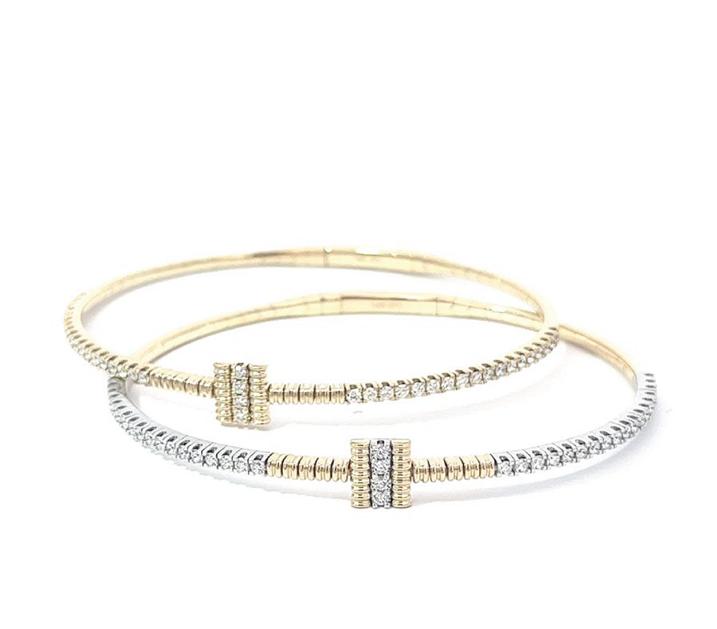
FLEXIBLE DIAMOND BRACELET
Flexible diamond bracelet with 0.62 ct available in yellow gold and two tone, 14k.
MSRP $2,925


FLEXIBLE DIAMOND SPIRAL RING
Flexible diamond spiral ring with 0.21 ct, size range 6.5 to 8, 14k.
MSRP $1,260

LOTUS BY PASS RING
18kt Yellow Gold Lotus By Pass Ring with 34 Round Diamonds totalling 0.34ct.
MSRP $4,000
BUBBLES DIAMOND FASHION PENDANT
SSNF0038
Elevate your style with the Bubbles Diamond Fashion Pendant in 14k Yellow Gold, featuring 3/4 ct of round lab-grown diamonds for a stunning touch of brilliance.
MSRP $1,650

LOTUS DANGLE EARRINGS
18kt Yellow Gold Lotus Dangle earrings with 8 Round diamonds totalling in 2.00 ct with 82 round totalling in 0.43ct.
MSRP $7,500
MARDINI COLLECTION
MRDTI-015-9AYBD
This 9mm comfort-fit band features a sleek & modern design, blending durable materials such as titanium, tantalum, carbon fiber, and 14K gold.
MSRP $1,775

YELLOW GOLD DIAMOND BANGLE
FSBG5044
Enhance your style with our elegant 14k yellow gold diamond bangle. Featuring 21 round+bg diamonds totaling 0.40 ct.
MSRP $1,999
MARDINI COLLECTION
MRDTN-052-7Y
This 7mm comfort-fit band, crafted from 14K gold, showcases a modern design with a laser-engraved tantalum center.
MSRP $1,825


CHUNKY OVAL PINCHED LINKS BRACELET
Wrist assure our Chunky Oval Pinched Link bracelet shines at every angle. This 7.75 inch bracelet is 14K solid gold and secures with a lobster lock.
MSRP $3,393

GRADUATED OVAL HOOP STUD EARRINGS
Sleek, shiny, and stunning. Dress your ear stack with eye-catching statement makers. These Graduated Oval Hoop Studs are made in 14K gold.
MSRP $1,113
CRISS CROSS YOUR WAY INTO FASHION!
Earrings from the ‘Criss Cross’ collection, made of 14K yellow gold and feature a mix of 1.66 ctw of round brilliant and baguette-cut lab-grown diamonds arranged in a criss-cross pattern.
MSRP $3,125

CLOVERS BRING YOU LUCK!
Clover shaped necklace from the ‘Mosaic’ collection, pendant features a central round brilliant-cut diamond surrounded by a halo of baguette-cut diamonds arranged in a clover-like design. 2.27 ctw of labgrown diamonds, set in 14k yellow gold.
MSRP $3,875
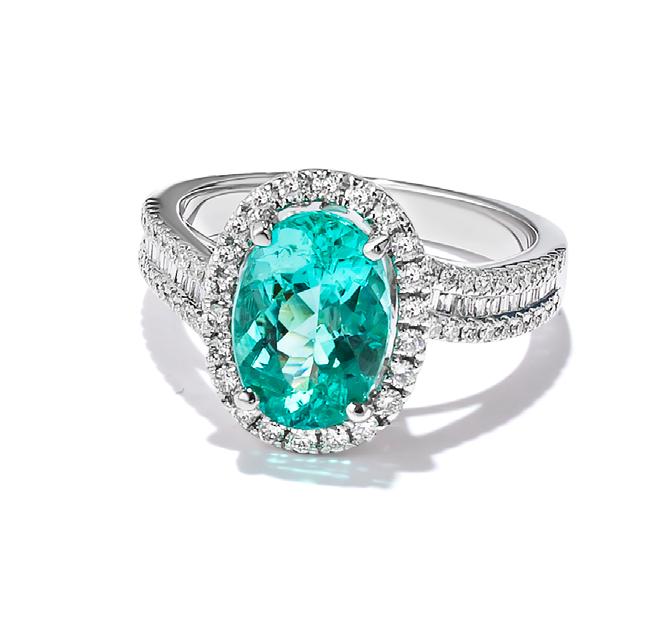
PARAIBA TOURMALINE FASHION RING
RT299WPAR-2
Discover the enchanting beauty of our Paraiba Tourmaline Ring, featuring a 2.70ctwcenter stone with a GIA report, embraced by 0.63ctw of glittering diamonds. A masterpiece of elegance and rarity.
MSRP $53,640

ORANGE SAPPHIRE THREE-STONE RING
RT478WOS-1
Behold the fiery elegance of our 6.04ctw Orange Sapphire Ring with a CDC report and framed by 0.64ctw of brilliant diamonds-- a symphony of warmth and luxury on your hand.
MSRP $23,712

DIAMOND FASHION BAND
18K white gold 1ct round/marquise diamond ladies band.
MSRP $4,990

DIAMOND CUFF BANGLE
18K yellow gold ½ ct round/baguette diamond and white ceramic cuff bangle.
MSRP $2,375

ETHEREAL DIAMOND NECKLACE
NK3730AA
Crafted in 18 karat white gold – this ethereal diamond necklace presents 190 marquise and pear shape brilliant cut diamonds totaling 41.34 carats. 1st Place Best Floral Design in Instore Design Awards 2024
MSRP $325,595
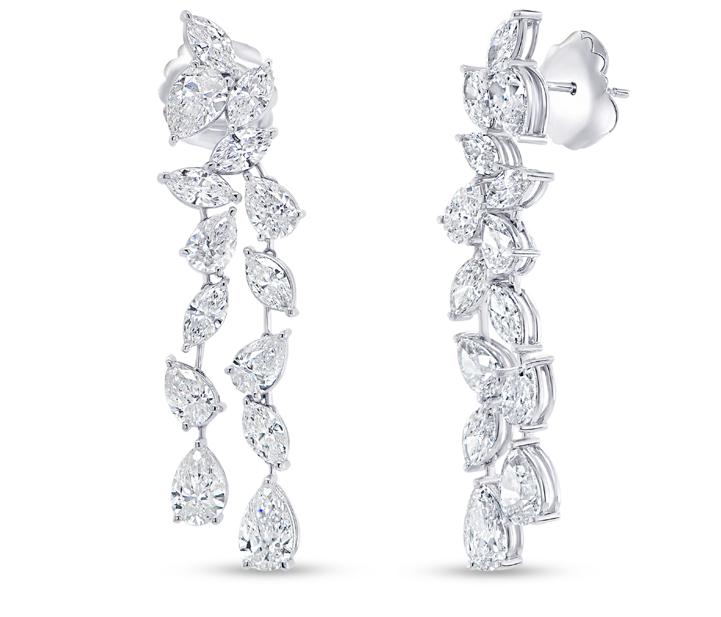
CLOVERS BRINGS YOU LUCK!
ER011
Indulge in elegance with this 18-karat white gold masterpiece outlined with 14 pear shaped diamonds weighing 5.51 carats, and 14 marquise diamonds amounting to 2.72 carats. 1st Place Best Statement Piece Over $10,000-$30,000 in Jewelers’ Choice Awards 2024.
MSRP $49,065


DIAMOND BAR STRETCH BRACELET
3285
18kt Gold beaded bracelet featuring .95ct vs diamonds and unique stretch mechanism of gold tubes connecting each bead.
MSRP $3,284

NATURAL PINK DORADO EARRINGS
VP24-10
14kt Yellow Gold drop earrings featuring 2.3ct of white diamonds, lustrous natural pink pearls, and removeable huggie clasps.
MSRP $8,699

AG COLOR ...............................................PAGE 47
AMPTIVE ............................................................................................................................PAGES 18-19
ASHI COUTURE .............................................................................................................PAGES 12-13
DE BEERS ...........................................................................................................................PAGES 16-17
DIALOG ...............................................................................................................................PAGE 27
DHARM INTERNATIONAL ........................................................................................PAGE 43
DILAMANI .........................................................................................................................PAGE 41
EPOQUE .............................................................................................................................PAGE 29
ETHOS CREATIONS ....................................................................................................PAGE 23
EVERSPARK ......................................................................................................................BACK COVER
GEMS ONE ........................................................................................................................PAGES 14-15
GUMUCHIAN ...................................................................................................................PAGES 4-5
IDD LUXE ............................................................................................................................PAGES 20-21
JEWELS BY JACOB .......................................................................................................INSIDE FRONT COVER, PAGES 1, 52A
KABANA .............................................................................................................................PAGE 39
KING BABY ........................................................................................................................PAGE 33
LESLIE MCGWIRE & ASSOCIATES INTERIOR DESIGN COMPANY.........PAGES 58-59
LUXURY DISPLAY GROUP .......................................................................................PAGES 36-37
MALO BANDS ..................................................................................................................PAGE 45
MERCURY RING .............................................................................................................PAGE 31
MIDAS ..................................................................................................................................PAGES 10-11
MONTAGNE .....................................................................................................................PAGE 51
RDI DIAMONDS .............................................................................................................PAGE 25
SAMUEL B. ........................................................................................................................INSIDE BACK COVER
SMILING ROCKS ...........................................................................................................PAGES 34-35
STEVEN ROYCE .............................................................................................................PAGES 6-7
UNEEK .................................................................................................................................PAGES 2-3
UNITED PMR PAGE 49
V & A LUXURY ................................................................................................................PAGE 22
VINCENT PEACH ..........................................................................................................PAGE 9















